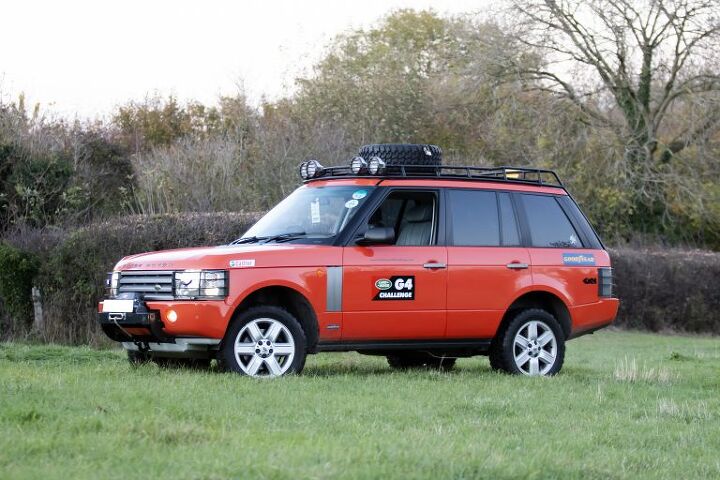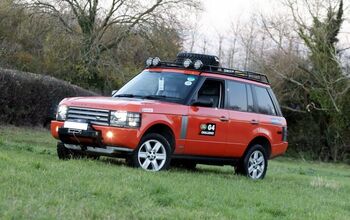Rare Rides: A Very Limited Edition 2002 Range Rover G4 Challenge (Part II)

In Part I of this very orange Rare Ride, we covered the love child of Rover, BMW, and (eventually) Ford which was the L322 Range Rover. Today we’ll talk about just what makes this one so special, aside from the glaringly orange paint.
The race known today as G4 had its roots in the early Eighties when cigarette maker Camel was the primary sponsor of the Camel Trophy off-roading challenge. In its kickoff year in 1980 teams used Jeeps, but every year after Land Rovers were used. The Camel used traditional Series Land Rovers, as well as the Defender, Discovery, and Freelander. The Camel Trophy sort of morphed as it went along through the year 2000, and in its last year had boats as its primary exploration vehicles. Land Rover felt the event was straying too far from SUV exploration and too near to lifestyle-ness and pulled its sponsorship a couple of years prior. At the end, RJ Reynolds (owner of Camel) had recently separated from Nabisco and was in the process of selling all non-US operations to Japan Tobacco circa 1999. Japan Tobacco chose to focus on its Camel Active clothing brand and did not pursue future instances of the Camel Trophy.
A couple of years later, teams from 16 different countries worked with Land Rover to reestablish a global off-road driving challenge, with Land Rover as the primary sponsor. The G4 was born and included similar events from the last time Land Rover participated in the Camel Trophy in 1998. Four different stages formed the “ultimate global adventure,” and took place in four different time zones. The inaugural event in 2003 offered as grand prize a fully-equipped Range Rover. The winner of the inaugural G4 declined the Range and said he wanted two Defenders instead. Land Rover obliged.
To participate during the 2003 G4, Land Rover prepared 31 Defenders, 30 Range Rovers, 62 Discovery IIs, and 30 Freelanders. Painted in Tangiers Orange, the Range Rovers were outfitted with a heavy-duty winch, front and rear brush guards, trailer hitches, underbody protection, rear roof access ladder, and a solid roof rack from Safety Devices. Additionally, there were extra lights on the outside for night time exploring, a roof-mounted spare wheel, and serious G4-spec Goodyear MTR tires. Fitting its mission of durable exploration, the Range Rover’s interior was outfitted in a basic dark gray and had many bits of brushed aluminum where there would normally be polished wood.
The Range Rover seen here was built for the later Australian sections of the challenge. Due to its photogenic location and the fact the Range Rover was the new hotness from Land Rover, it became the most photographed vehicle in the event. After G4, it was presented on posters and in Land Rover marketing materials and catalogs. At some point, it was sold off by Land Rover into private hands, but not before being stripped of its unique G4 parts. A longstanding tradition since the Camel Trophy, buyers of used Camel/G4 cars occupy their time with restoring their special use Land Rovers back to competition appearance at great expense. Then they never use them off-road again because they’re valuable collector’s items covered in unobtainium aftermarket parts.
The G4 Challenge persisted through 2007, at which point it became a more charity-oriented event as Land Rover linked up with the Red Cross. In the latter part of 2008, Land Rover decided to cancel the 2008-2009 scheduled events in Mongolia due to the financial crisis. The company has never reinstated the challenge.
There’s still time left to bid on today’s G4 Range Rover. As of writing it was near its reserve, and bid up to $24,654.
[Images: seller]

Interested in lots of cars and their various historical contexts. Started writing articles for TTAC in late 2016, when my first posts were QOTDs. From there I started a few new series like Rare Rides, Buy/Drive/Burn, Abandoned History, and most recently Rare Rides Icons. Operating from a home base in Cincinnati, Ohio, a relative auto journalist dead zone. Many of my articles are prompted by something I'll see on social media that sparks my interest and causes me to research. Finding articles and information from the early days of the internet and beyond that covers the little details lost to time: trim packages, color and wheel choices, interior fabrics. Beyond those, I'm fascinated by automotive industry experiments, both failures and successes. Lately I've taken an interest in AI, and generating "what if" type images for car models long dead. Reincarnating a modern Toyota Paseo, Lincoln Mark IX, or Isuzu Trooper through a text prompt is fun. Fun to post them on Twitter too, and watch people overreact. To that end, the social media I use most is Twitter, @CoreyLewis86. I also contribute pieces for Forbes Wheels and Forbes Home.
More by Corey Lewis
Latest Car Reviews
Read moreLatest Product Reviews
Read moreRecent Comments
- Jeff My wife owned a 2013 AWD CRV since new it has been trouble free but I am not a fan of turbos so I would lean toward the Rav 4. If I were getting a hybrid it definitely would be a Rav 4 with Toyota's hybrid system being the best. Honestly you could not go wrong with either a CRV or a Rav 4. My third choice would be a Mazda.
- 3-On-The-Tree We like our 2021 Rav4 non hybrid.
- Vatchy FSD never has been so what is with the hype about robo-taxis? You would need the first in order for the second to work.
- EBFlex Honda all day long. Why? It's a Honda.
- Lou_BC My ex had issues with the turbo CRV not warming up in the winter.I'd lean to the normally aspirated RAV 4. In some cases asking people to chose is like asking a Muslim and Christian to pick their favourite religion.







































Comments
Join the conversation
Peak... nothing.
This is one of the cars available in the Steam Workshop for Spintires and Mudrunner.